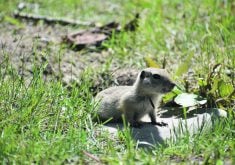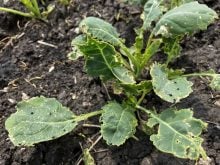The largest living terrestrial being on Earth isn’t a whale, elephant or giant sequoya. It’s a 9,000-year old mushroom that measures 5.5 kilometres across and eats fir trees.
There’s a total of 10 trillion or more types of soil bacteria. There can be more than a million in a teaspoon of soil. When we narrow this general branch of soil bacteria down to soil fungi only, we still have a list of 100 billion types.
One single big parasite in particular, called the honey fungus or honey mushroom, Armillaria solidipes, has a strong population in British Columbia, Washington and Oregon, according to Jesse Morrison, a forage plant breeder at Mississippi State University.
Read Also

Growing garlic by the thousands in Manitoba
Grower holds a planting party day every fall as a crowd gathers to help put 28,000 plants, and sometimes more, into theground
The law of the jungle says “you eat it before it eats you.” Loggers in the Pacific Northwest probably feel that way about the honey mushroom because of the fact that it has an appetite for fir trees. The fungus feeds on the very trees needed by the lumber industry, making it a very unpopular part of the local ecology.
It gained notoriety in the late 1990s as the secret killer attacking fir trees on the West Coast. Fir is considered to be the best of the softwood lumber species. The natural action of the fungus has led to widespread die-off in stands of fir.
According to the Soil Science Society of America, honey mushrooms grow to such a tremendous size because individual mushrooms can fuse together into larger mushrooms when they touch. Morrison said these characteristics of the fungi could be put to good use by plant breeders, once they’re understood.
“When mycelia from different individual honey fungus bodies meet, either down in the soil or up on the surface, they attempt to fuse to each other,” Morrison said.
“The fungi must be genetically identical. When the mycelia successfully fuse to each other, they link very large fungal bodies together. This, in turn, changes extensive networks of fungal ‘clones’ into a single giant individual.”
Mushrooms typically grow on moist logs or saturated soil with wet rotting vegetation. The fungi break down decaying plant material into nutrients that other plants then access to grow.
However, parasites can damage their host organisms. In the case of honey mushrooms, they grow in individual networks called mycelia, which function like plant roots. They draw water and nutrients from the soil to feed the fungus. If there are weakened or stressed trees, the mushroom robs enough water and nutrient to kill them. The larger the mycelia grows, the hungrier it becomes.
However, there is one positive aspect of the underground network of mycelia of all fungi. They help hold soil particles together. Just like plant roots, mycelia work to prevent soil erosion from wind and water. This is especially important in the Pacific Northwest because of the predominance of steeply sloped landscapes.
Morrison said the underground structures are generally not found very deep in the soil. Honey fungi are aerobic organisms, meaning they must have access to oxygen in order to survive. The extent to which they’re found is completely dependent on soil structure and texture.
As you dig deeper in the soil profile, you encounter increasingly compact layers of soil, generally too low in oxygen to support fungi. In the deepest forest soils of the Pacific Northwest, they occur as deep as 1 1/2 meters. However, they can colonize around roots of infected trees, so you could potentially find them at depths up to 3 1/2 metres.
Morrison, who specializes in forage agronomy and plant breeding, said there’s an obvious positive aspect of the honey fungus and associated research. In an email interview, he said that understanding how it can develop a massive mycelia system that extends for miles may be the key to breakthroughs in health and agriculture.
“As a plant breeder, I see two types of potential benefits. This is a parasitic fungus, which is generally something we avoid in agriculture. But the traits that make it so effective at taking over individuals such as large trees could be useful in the future of agriculture,” he said.
“Geneticists are looking for ways to combat toxic fungi in human food crops. If they can identify and harness the genes responsible for the aggressive nature of honey fungus, it could be of particular benefit in fighting crop diseases.
“Also, these fungi are remarkably adept at breaking down organic compounds, both beneficial and non-beneficial. The opportunities to test honey fungus as a potential candidate in ‘myco-remediation’ are always present and worth a shot, I think. Perhaps one day, research discoveries about honey fungus could lead to a new medicine or new ways to grow food. The possibilities are endless.”
Contrary to popular belief, honey fungus is not named for flavour. It’s anything but sweet. It’s named for the honey-like colour of its cap, said Morrison.
“It’s mildly poisonous to humans in raw form, but it’s edible when fully cooked,” he said.
“Honey fungus is widely regarded in wild food foraging circles as a highly prized find. Across several European countries, honey fungus is not only considered edible but is held in high regard with a flavour exceeding that of morels and chanterelles. A famous Italian chef, Antonio Carluccio, says it’s delicious with spaghetti and red chili.”
However, it’s not likely that human demand will consume enough of the fungus to solve the fir tree problem in the Pacific Northwest.


















